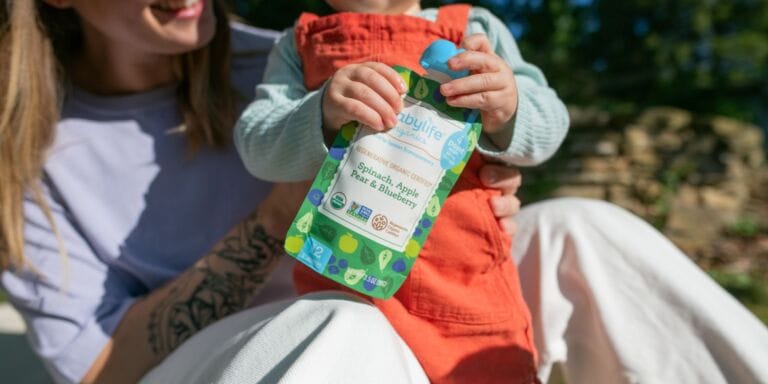4-month-old baby health & growth guide

Hananeko_Studio/Shutterstock
Month four can be full of sweet daytime giggles—and up-all-night-teething cries.
We independently select and share the products we love—and may receive a commission if you choose to buy.
Table of Contents
Welcome to month 4! Your bubbly baby is ready to engage with their environment, from playing with toys to turning toward your face and voice and starting to giggle on their own (is there anything sweeter?). They might soon be ready to roll over, too. There’s a lot happening these days, and sleep changes are a big part of that. Though sleep starts to get even more consolidated this month, you might see some challenging nights in the near future—but not to worry. We have a helpful way to reframe the dreaded “4-month sleep regression” for you. Here’s what to know about your baby’s health and growth in month four.
Related: 4-month-old baby milestones
4-month-old baby nutrition
Whether you’re breastfeeding, formula feeding or combination feeding, we’re betting you’re a pro at recognizing your baby’s feeding cues. Your 4-month-old’s eating habits are hopefully starting to become more aligned around a schedule, now, too, which makes it easier to plan out your day if you have other commitments, like work or taking care of other children. A breastfed baby will still eat around 6 to 8 times in a 24-hour period, and a formula-fed baby will eat around 6 times.
Feeding
According to The American Academy of Pediatrics and La Leche League, at 4 months old, babies should be consuming the following amounts at the suggested times below, but remember to follow your baby’s hunger cues. The schedule below is just a suggestion.
How much to feed a 4-month-old baby
Breast milk: 4 to 6 ounces every 3 to 4 hours
Formula: 4 to 6 ounces every 4 hours
Read more: 4-month-old baby feeding schedule & amounts
Common feeding issues: What to know about food allergies
Wondering if your 4-month-old baby has a food allergy? As you breastfeed, small traces of the food you eat make their way into your breast milk, and some foods can cause a reaction in your baby. First, know that most babies don’t have a reaction to their mother’s breast milk. Experts generally recommended that breastfeeding mothers should follow their current diet, and change it only if they notice signs of a food allergy or intolerance in their baby.
Signs of food allergy or intolerance in babies:
- Skin rashes, such as eczema or hives
- Swelling
- Diarrhea or frequent bowel movements
- Excessive gas
- Abdominal cramping or pain
- Constipation
- Mucus or blood in the stool
- Vomiting or reflux (spitting up or “silent” reflux)
- Severe colic/extreme fussiness
- Wheezing or difficulty breathing
How to know if it’s an allergy or intolerance
True allergic reactions are typically more severe in how they present. You might notice symptoms such as vomiting, wheezing, hives and blood in stool. For an intolerance, symptoms are much more gradual and understated, including irritability, eczema, reflux and stool issues.
The most common sources of food allergies and intolerances are:
- Dairy (cow’s milk protein); this is the most common offender
- Eggs
- Soy
- Wheat
- Peanuts
- Tree nuts
- Sesame
- Fish
- Shellfish
What to do if you suspect a food allergy or intolerance
If you think your breastfed baby might have a food allergy or intolerance, the best method is to eliminate the food from your diet for 2 to 3 weeks to see if your baby’s symptoms improve. Note that symptoms may not improve immediately—it may take a week or longer for your little one to start to feel better, as some allergens, like cow’s milk proteins, can still circulate for up to 3 weeks after elimination.
If you suspect an allergy or intolerance in your formula-fed baby, talk to your child’s pediatrician about changing to a hypoallergenic formula that uses a hydrolyzed casein-based protein, which may be better tolerated. Goat’s milk or soy protein formulas are also available, and may be worth trying, though some infants with cow’s milk protein allergy will also react to soy or goat’s milk. Your pediatrician should be able to help figure out the best path forward.
Introducing some allergens at 4 months
Though it’s generally not recommended to start introducing solids before 6 months, if your child is deemed by their doctor to be at high risk for developing severe food allergies, introducing some allergenic foods (such as peanut powder) at 4 months may be recommended. Be sure to talk to your child’s pediatrician to discuss and learn more.
4-month-old baby weight
For babies up to 2 years of age, the Centers for Disease Control and Prevention (CDC) recommend using the World Health Organization (WHO) weight and length charts.
The WHO growth charts for babies 0 to 2 years are based on what is standard for a predominantly breastfed infant. According to the organization, the WHO charts reflect growth patterns among children who were predominantly breastfed for at least 4 months and were still breastfeeding at 12 months. The American Academy of Pediatrics (AAP) recommends continuing to breastfeed for at least two years, as long as it benefits both mother and baby.
How much does the average 4-month-old weigh?
By 4 months, many babies have doubled their birth weight. You can expect your little one may gain another 1 pound to 1.25 pounds this month.
According to the WHO:
- A 4-month-old baby boy in the 50th percentile weighs 15 pounds, 7 ounces (7 kilograms)
- A 4-month-old baby girl in the 50th percentile weighs 14 pounds, 2 ounces (6.4 kilograms)
What factors contribute to a 4-month-old baby’s weight?
At this stage, your baby’s weight may be a factor of their birth weight, their assigned sex and how they’re fed.
Size at birth: The weight of your baby at birth will influence their weight now. Babies born preterm may weigh less than babies born full or late term.
Assigned sex at birth: Males tend to gain weight slightly faster than females.
How they’re fed: According to AAP, breastfed babies may gain weight slightly faster than formula-fed babies in the first 6 months of life.
Related: Activities for a 4-month-old: Fostering baby’s development
4-month-old baby length
In month four, you can expect your baby to grow another 0.8 inches (about 2 centimeters).
How long is the average 4-month-old?
According to the WHO:
- A 4-month-old baby boy in the 50th percentile is 25 1/4 inches long (63.9 cm)
- A 4-month-old baby girl in the 50th percentile is 24.5 inches long (62.1 cm)
What factors contribute to a 4-month-old baby’s length?
Boys tend to be slightly taller than girls, but general nutrition and overall health also plays a role: chronic disease during childhood can affect future growth and development. Height can also be hereditary: The height of a baby’s parents and other family members strongly influences their future height. Interestingly, one study identified that babies tend to grow after long naps and nighttime sleep.
Growth charts and percentiles
At your child’s 4-month well-check, the pediatrician will plot their weight, length and head circumference on a growth chart, the same one they’ve used since they were born. Growth charts show how a baby’s weight or length may be compared to the weight or length of other babies of the same age, and how your baby has grown over time.
But know that growth charts are just one tool used to track a child’s development (along with developmental milestones and feeding and sleep habits), and aren’t meant to be used alone.
Let’s say your baby’s weight is in the 65th percentile. That means that 35% of babies of the same age and sex weigh more, and 65% of babies weigh less. Remember, all babies grow at their own pace: healthy babies can be in the 5th percentile and the 95th percentile. What’s most important? Steady and sustained growth over time. Your child’s pediatrician will be looking at the overall growth pattern, or curve, to see the general trends.


Growth spurts
If your little one seems hungrier or fussier lately, it could mean they’re going through a growth spurt. You might notice a big growth spurt right at the beginning of the fourth month, lasting anywhere from a few days up to a week.
Growth spurts are associated with leaps in both growth and development, and your 4-month-old is working on both. From doubling their birth weight since their first week to working on rolling over and sharpening their vision, there’s a lot going on. You might notice your little one wants to feed more often in the evening or is waking up more frequently at night. Don’t stress—it’s just temporary.
When should I worry about my baby’s growth?
Your 4-month-old baby should be scheduled for a well-check this month, during which your pediatrician will plot your child’s weight, length and head circumference and analyze the arc. If they’re worried about their growth curve, they’ll let you know. Otherwise, try not to stress too much: All babies grow at different rates.
4-month-old baby sleep
Your 4-month-old baby’s wake windows are stretching out even more now, which means more time for play, outdoor walks and tummy time. Though you should still be aiming for 12 to 16 hours of sleep per 24 hours, with around 10 to 12 hours of consolidated night sleep, according to the American Academy of Sleep Medicine.
The 4-month sleep regression
But the biggest change that happens this month? Melatonin production kicks in—which can result in what’s known as the 4-month sleep regression.
If you’ve heard horror stories from other parents, try not to panic, says certified baby sleep consultant Rachel Mitchell. “This is often the stage that parents start to dread the anticipated ‘4-month sleep regression,’ but what is actually happening is that your baby is making big leaps developmentally and this is more of a progression,” she says.
Your infant may wake more often at night or have trouble settling down for sleep this month, but reframing the regression as a progression can hopefully help make this period a little less trying—you know there’s a purpose to all the turmoil. If you haven’t yet set a consistent bedtime routine, now’s the time. Talk to your doctor about dropping one nighttime feed or starting to sleep train, if that appeals.
Related: Gentle sleep training saved my marriage
What baby sleep looks like at 4 months:
- Your baby may be taking 3 to 4 naps per day
- Your baby may be sleeping in 3- to 6-hour windows at night
- Your baby may be awake for 90 to 120 minutes at a time
Read more: How much sleep does a 4-month-old baby need?
When to stop swaddling
Once your infant starts rolling, it’s time to stop swaddling. For many babies, this happens around the 4-month mark, but it could happen earlier—around 2 months if your baby is an early roller. Because swaddled babies don’t have their arms free to push themselves up after rolling, swaddling a baby for sleep who can roll over could be a risk factor for SIDS. One way to avoid this? Transition to having baby sleep in a swaddle with one arm out, and then both arms out.
We like the Happiest Baby Sleepea swaddle, which makes it easy to switch to a one-armed or arms-free swaddle. Be sure to avoid weighted swaddles and sleep sacks: The AAP warns that they can place too much pressure on baby’s chest and lungs.
Related: 10 safe sleep guidelines every parent, grandparent and caregiver should know
Diapering a 4-month-old
Keep on keeping an eye on your baby’s diapers—your 4-month-old should be having 5 to 7 wet diapers a day, and though there’s a wide range of normal when it comes to poop, you probably have a good sense of what constitutes ‘normal’ for your baby when it comes to bowel movements, too. Anything that feels outside the range of what’s typical for your baby might warrant a quick call to the pediatrician.
Remember that for breastfed babies, stool should be soft and slightly runny. For formula-fed babies, stool should be paste-like or peanut-butter consistency, but not hard. If your baby has hard, formed or pellet-like stools, call your pediatrician, as it may be a sign of constipation.
Caring for a 4-month-old
At your baby’s 4-month checkup, they’ll receive the next round of the same vaccines they received at their 2-month appointment. It’s important to keep your child on schedule with regard to their childhood vaccinations so that they can receive vaccine-provided immunity early in life, before they come into contact with potentially life-threatening diseases.
Vaccines for 4-month-olds
Your baby will likely receive the following vaccines at their 4-month checkup:
- Rotavirus (RV)
- Diphtheria, tetanus, & acellular pertussis (DTaP)
- Haemophilus influenzae type b (Hib)
- Pneumococcal conjugate (PCV13, PCV15)
- Inactivated poliovirus (IPV)
Related: Pfizer’s RSV vaccine for pregnancy could be available soon
The list might seem long, but know that these vaccines support your child’s immune system by helping it fight off deadly yet preventable diseases that might otherwise overwhelm them. The vaccines themselves won’t overwhelm their immune system: Vaccines use tiny amounts of antigens to help your baby’s body recognize and fend off serious disease. If you have other questions or concerns, be sure to speak with your child’s pediatrician.
To help make your little one more comfortable during vaccinations, aim to start breastfeeding or bottle feeding just before the shot happens and during the shot administration. The suckling action is soothing and can provide some pain relief for babies, as can the sweetness of breastmilk or formula.
Related: Want tear-free shots? The Shotblocker and Buzzy Bee can help
Baths
Remember that babies at this age rarely get that dirty, so daily baths aren’t a necessity. But if you’ve found a schedule or routine that works for you, stick with it. Short baths can be soothing if your little one enjoys them, and they can make for a relaxing part of their bedtime routine.
Common concerns
New up this month? Teething. We knew all that drool was in the picture for a reason…
Teething
If your little one seems fussier than usual, has reddened cheeks, extra saliva and stuffiness (and diarrhea from all that extra saliva), or even a mild fever, they might be cutting their first teeth. Many babies start teething between 4 and 7 months. This is a milestone moment, to be sure, but it’s not one of the most enjoyable. Teething hurts—and your baby will likely (loudly) let you know. Luckily, there are a few baby-safe ways to help reduce teething pain.
How to reduce baby teething pain:
- Gently rub their sore gums with your clean finger
- Offer them a wooden or silicone teething ring
- Give baby a clean, cold, wet washcloth to suck on
- Play white noise for all naps and night sleeps to help distract from the pain
Related: How to help a teething baby: do’s and don’ts
A note from Motherly on self-care while caring for a 4-month-old
Month four can be full of sweet daytime giggles—and up-all-night-teething cries. Time for a check-in: How are you *really* doing these days? Caring for an infant can be all-consuming, which is why it’s key to periodically take stock of your own emotions and mental health. After all, if your cup isn’t full, it’s so much harder to take care of your little one. Now that baby’s a bit older, it’s a good time to schedule a day to date yourself again—in addition to a date night with your partner and an outing with your best friends. Yep, you deserve it all.
If you feel like you’re struggling more than you’re used to, reach out to a mental health expert, who can help address your symptoms. Postpartum depression can set in anytime in the first year after birth, but help is out there.
Look ahead: 5-month-old baby health & growth guide
Postpartum mental health resources
If you’re experiencing any postpartum mood symptoms, no matter how mild, know that help is available. Reach out to your healthcare provider about next steps and potential treatment options, such as more support at home, therapy or medication. If you’re in crisis, reach out to a crisis hotline or dial 988 or 911 for immediate support.
The phone numbers listed below are available 24/7 to help you with suicidal thoughts or other mental health crises.
- The National Maternal Mental Health Hotline: 1-833-TLC-MAMA (1-833-852-6262)
- Available in English and Spanish and in a completely confidential line.
- Postpartum Support International: 1-800-944-4773 (call or text)
- Available in English and Spanish
- National Crisis Text Line: Text HOME to 741741
- National Suicide Prevention Hotline: Call or text 988
- Available in English and Spanish
A version of this story was originally published on March 24, 2023. It has been updated.









































